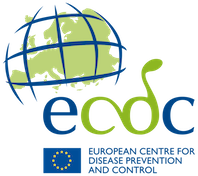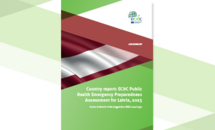Country report: ECDC Public Health Emergency Preparedness Assessment for Latvia, 2025
ECDC has the responsibility, in coordination with relevant Union agencies and bodies, to conduct Public Health Emergency Preparedness Assessments of all European Union and European Economic Area (EU/EEA) countries every three years regarding the state of implementation of their national prevention, preparedness and response planning. This report presents the findings and recommendations of the first assessment conducted in Latvia.
Executive summary
Background
The aim of the Public Health Emergency Preparedness Assessment, as mandated in Article 8 of the Regulation (EU) 2022/2371 on serious cross border threat to health, is to improve prevention, preparedness and response planning in EU/EEA countries through the implementation of recommendations following individual country assessments. As specified in the Regulation, each EU/EEA country will undergo an assessment every three years, with the first cycle of these occurring between 2024 and 2026.
This report presents the findings and recommendations of the first assessment conducted in Latvia. This involved a desk review of relevant documents, followed by a five-day country visit that took place between 17 and 21 March 2025. As per the assessment methodology, all of the 16 capacities included in Article 7 of the Implementing Regulation (EU) 2023/1808 self-assessment template were assessed, with five of them considered in-depth: Laboratory (Capacity 3); Surveillance (Capacity 4); Health Emergency Management (Capacity 6); and Antimicrobial resistance (AMR) and Healthcare-Associated Infections (HAI) (Capacity 12) and Zoonotic diseases and threats of environmental origin, including those due to the climate (Capacity 10). The report also provides specific recommendations for the country to improve prevention, preparedness and response planning. Latvia is requested to provide an action plan addressing these recommendations within nine months of receiving this report.
Key findings
Latvia’s national health system is centralised, with a strong role for the state. A WHO Joint External Evaluation was carried out in Latvia in 2017. The National Disaster Medicine Plan (the National Preparedness and Response Plan for the health care sector) focusses on the responsibilities and actions of the health sector institutions to ensure a comprehensive approach to health emergency management. The Plan, which is updated regularly, covers multiple hazards and considers both the strategic and operational levels. All health sector institutes and hospitals plan for the contingency of their services, with the exception of primary care providers. The National Risk Assessment also addresses health risks and is complemented by sectoral risk-assessment.
The Incident Management System at national level is composed of the State Operational Medical Commission, under the Ministry of Health, and the Crisis Management Council, under the Cabinet of Ministers. The different layers of stockpiles are coordinated, and the State Emergency Medical Service can rapidly obtain information on hospitals stocks through the IT system ‘In-patient medical institution resource information system’ (SAIRIS), which can facilitate reallocation. In addition to existing national medical stocks, there is a plan for the establishment of state-owned stocks of critical medicines, and there have been discussions on strengthening medicine supply chains with Estonia and Lithuania.
A tier-based laboratory system is in place, consisting of local private and public laboratories, hospital laboratories and national microbiology reference laboratories, representing both the human and animal sectors. Facilities for BSL-3 services are in place, but access to a BLS-4 facility has not been formalised. There are whole-genome sequencing (WGS) instruments and competence exists for the production and analysis of data in NMRL, but limited sequencing is conducted. Biosafety and biosecurity measures are in place, but further elaboration of capacities and routines are needed. Sample transportation functions cover routine diagnostic needs, but are insufficient for effective operation in outbreak/threat situations.
The VISUMS disease surveillance system is outdated and involves multiple manual processes, limiting efficient outbreak detection and control. The new system EPID, developed for COVID-19 surveillance, functions well but cannot receive surveillance data for other diseases. Sentinel ILI/ARI/SARI surveillance is in place although there is no sample collection for ILI/ARI cases or linkage to patient data for SARI cases. The Latvian Centre for Disease Prevention and Control does not follow a formalised assessment procedure for daily threat assessment. Hospital capacity information is continuously available in SAIRIS, and testing capacity and contact tracing capacity can be monitored on a daily basis, as well as during a public health emergency.
There is an acute need to build capacity for some key national-level activities in AMR and HAI surveillance and control. There is an epidemic of carbapenem-resistant Enterobacterales (CRE) in hospitals, with molecular evidence of cross-facility spread. The standard hygiene plan is under revision, and this represents an opportunity to strengthen the infection prevention and control infrastructure in hospitals. There has been progress with the National Action Plan (NAP) for AMR, with mid-term evaluation and the development of legislation for the intersectoral collaborating mechanism underway. There has also been progress with national antimicrobial stewardship activities since the establishment of the AMR Competence Centre in 2024.
With regard to One Health governance, there is good formal and informal horizontal and vertical cooperation between public health and food and veterinary services. There is collaboration between reference laboratories in the human and animal health sector, but no comprehensive One-Health approach to disease prevention and control, and links to the environmental sector are limited. There is a list of cross-sectoral notifiable diseases for early detection and outbreak investigations. Emerging zoonotic disease surveillance, including molecular surveillance, is partly project-based and partly dependent on available annual funding. It was indicated that there are limited resources for routine public health and certain veterinary, One-Health surveillance tasks across Latvia, including human resources, technical infrastructure, and operations such as training and lessons-learned activities.








